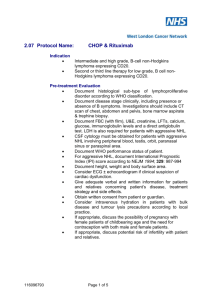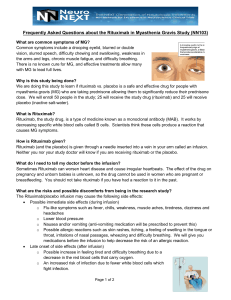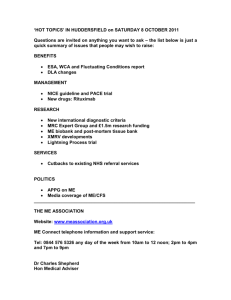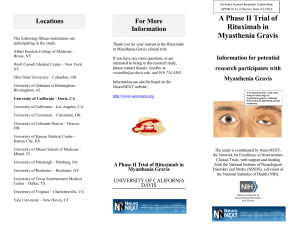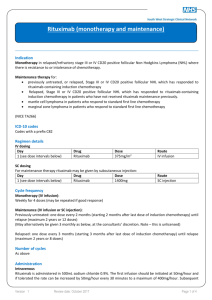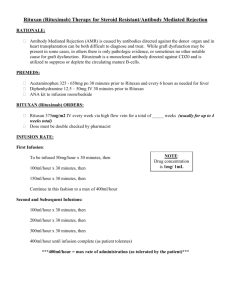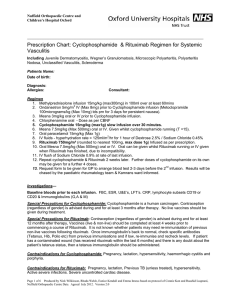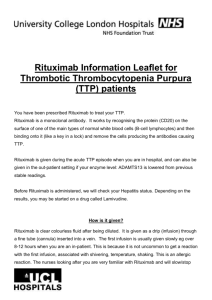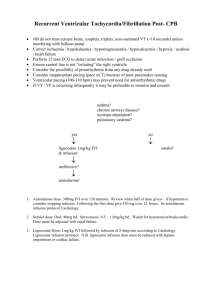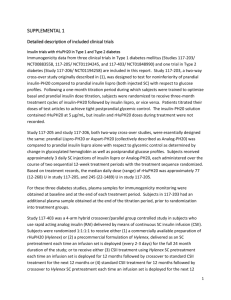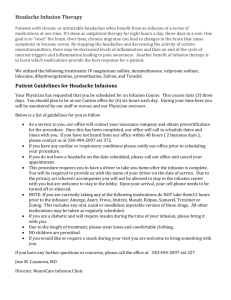6.02 DRC version 1.1
advertisement
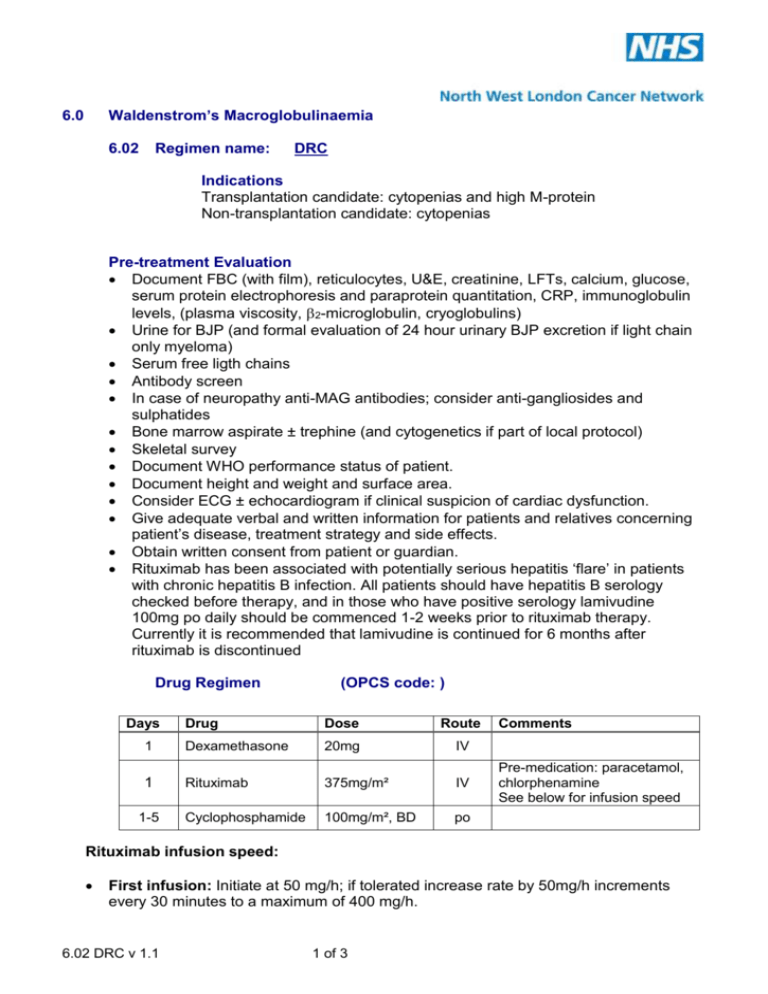
Waldenstrom’s Macroglobulinaemia 6.0 6.02 Regimen name: DRC Indications Transplantation candidate: cytopenias and high M-protein Non-transplantation candidate: cytopenias Pre-treatment Evaluation Document FBC (with film), reticulocytes, U&E, creatinine, LFTs, calcium, glucose, serum protein electrophoresis and paraprotein quantitation, CRP, immunoglobulin levels, (plasma viscosity, 2-microglobulin, cryoglobulins) Urine for BJP (and formal evaluation of 24 hour urinary BJP excretion if light chain only myeloma) Serum free ligth chains Antibody screen In case of neuropathy anti-MAG antibodies; consider anti-gangliosides and sulphatides Bone marrow aspirate ± trephine (and cytogenetics if part of local protocol) Skeletal survey Document WHO performance status of patient. Document height and weight and surface area. Consider ECG ± echocardiogram if clinical suspicion of cardiac dysfunction. Give adequate verbal and written information for patients and relatives concerning patient’s disease, treatment strategy and side effects. Obtain written consent from patient or guardian. Rituximab has been associated with potentially serious hepatitis ‘flare’ in patients with chronic hepatitis B infection. All patients should have hepatitis B serology checked before therapy, and in those who have positive serology lamivudine 100mg po daily should be commenced 1-2 weeks prior to rituximab therapy. Currently it is recommended that lamivudine is continued for 6 months after rituximab is discontinued Drug Regimen Days (OPCS code: ) Drug Dose Route 1 Dexamethasone 20mg IV 1 Rituximab 375mg/m² IV Cyclophosphamide 100mg/m², BD po 1-5 Comments Pre-medication: paracetamol, chlorphenamine See below for infusion speed Rituximab infusion speed: First infusion: Initiate at 50 mg/h; if tolerated increase rate by 50mg/h increments every 30 minutes to a maximum of 400 mg/h. 6.02 DRC v 1.1 1 of 3 Subsequent infusions: Initiate at 100 mg/h; if tolerated increase rate by 100mg/h increments every 30 minutes to a maximum of 400 mg/h. High tumour burden: Consider reduction of infusion rate in patients with circulating tumour cells of > 50 x 109/l or with high tumour burden. Fast rate infusion: Many day-care units have implemented this locally as a safe and time efficient method of reducing the infusion time. Patients MUST have tolerated their first cycle of rituximab (at the standard recommended infusion rates as specified above) before being given the rapid infusion rate. All rituximab doses are prepared in 250mls 0.9% sodium chloride, with 50mls being given over the first 30 minutes and the remaining 200mls given over 1 hour. If a 500ml volume of 0.9% sodium chloride is used, then 100mls is given over the first 30 minutes and the remaining 400mls given over 1 hour. Cycle Frequency and Duration Repeated every 21days for 6 courses Dose Modifications Renal impairment: Cyclophosphamide: CrCl >50ml/min: 100% dose CrCl 10-50ml/min: 75% dose CrCl <10ml/min: 50% dose Investigations prior to subsequent cycles FBC, U+E, Creat and LFTs Serum protein electrophoresis and paraprotein quantitation, CRP, 2microglobulin and immunoglobulin levels Concurrent Medication Allopurinol 300mg od PO (100mg if significant renal impairment) for first 2 cycles Anti-emetics This regimen has moderate emetic potential - refer to local protocol Reference Dimopoulos M A, Anagnostopoulos A, et al. Primary treatment of Waldenstrom’s Macroglobulinaemia with dexamethasone, rituximab and cyclophosphamide. J Clin Oncol, 2007, 25: 3344-3349 6.02 DRC v 1.1 2 of 3 Patient Information http://www.macmillan.org.uk/Cancerinformation/Cancertreatment/Treatmenttypes/Supp ortivetherapies/Steroids.aspx http://www.cancerbackup.org.uk/Treatments/Biologicaltherapies/Monoclonalantibodies/ Rituximab http://www.macmillan.org.uk/Cancerinformation/Cancertreatment/Treatmenttypes/Che motherapy/Individualdrugs/Cyclophosphamide.aspx Written by: Dr S Abdalla, Dr A Rahemtulla, Dr S Kirschke, September 2009 Authorised by: WLCN Haematology TWG, March 2010 Date for review by Haematology TWG: March 2011 6.02 DRC v 1.1 3 of 3
